Dr. Seuss, a name synonymous with whimsical children’s literature, took a surprising detour into the realm of live-action musical fantasy with 1953’s The 5000 Fingers of Dr. T. This film, a collaboration with producer Stanley Kramer, is a bizarre and imaginative cinematic experience that delves into childhood anxieties and presents a world as eccentric and unsettling as any of Seuss’s beloved books. While the movie faced a troubled production and initial negative reception, The 5000 Fingers of Dr. T has since garnered a cult following for its originality, inventive musical numbers, and surprisingly dark undertones.
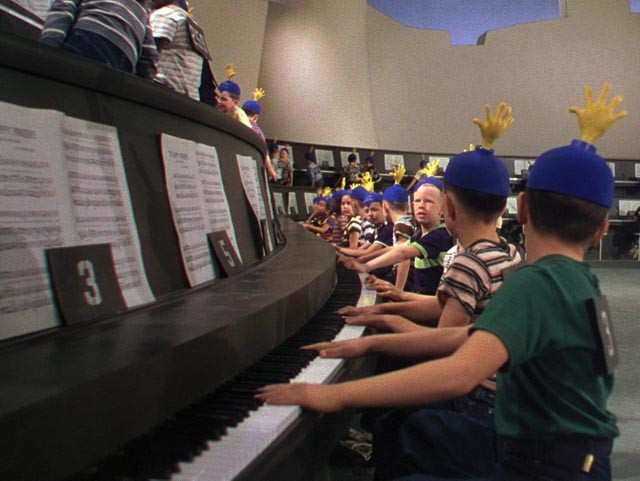 Music lessons as a metaphor for fascism in Dr. Seuss
Music lessons as a metaphor for fascism in Dr. Seuss
Conceived by Theodor Geisel, before he was universally known as Dr. Seuss, The 5000 Fingers of Dr. T was initially intended as a directorial project for Kramer, with whom Geisel had worked during their time in the Signal Corps. The film’s visual design, crafted by Rudolph Sternad, aimed to bring Seuss’s distinctive artistic style to life in three dimensions. Adding to the film’s unique flavor was the music by Frederick Hollander, a composer with roots in Weimar cabaret, reminiscent of Kurt Weill’s style. Hollander’s background included composing for Berlin cabarets in the 1920s and writing iconic songs for Marlene Dietrich in The Blue Angel. Roy Rowland eventually took over the directorial reins, resulting in a film that stands out as an anomaly in his otherwise conventional filmography.
Despite its ambitious concept and creative team, The 5000 Fingers of Dr. T was made at Columbia Pictures, a studio not typically associated with musicals, especially those venturing into such unconventional territory. Early previews were disastrous, leading producer Kramer to significantly re-edit the film, reportedly cutting numerous musical sequences and substantial runtime. The resulting 89-minute film is a concentrated exploration of Oedipal anxieties, totalitarian fears, and the shadow of nuclear dread, all filtered through the lens of a child’s nightmare.
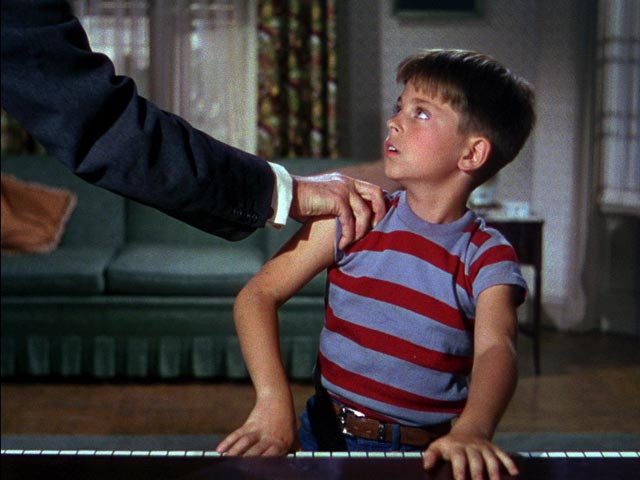 Young Bart Collins (Tommy Rettig) resists the oppression of Dr. Terwilliker (Hans Conried) in Dr. Seuss
Young Bart Collins (Tommy Rettig) resists the oppression of Dr. Terwilliker (Hans Conried) in Dr. Seuss
The narrative centers on young Bart Collins, portrayed by Tommy Rettig, who feels trapped by the relentless piano practice demanded by his overbearing teacher, Dr. Terwilliker, played with manic energy by Hans Conried. Dr. Terwilliker, or “Dr. T,” is a musical tyrant who despises all instruments except the piano and insists on Bart’s unwavering dedication to his practice. Bart’s mother, Heloise (Mary Healy), has fallen under Dr. T’s spell, becoming his assistant and fiancée. In his desperation, Bart seeks support from the family plumber, Mr. Zabladowski (Peter Lind Hayes), but the plumber is too preoccupied with his work to heed Bart’s warnings about Dr. T’s sinister nature.
Falling asleep at the piano, Bart enters a nightmarish dreamscape: Dr. T’s Happy Fingers Institute. Here, he discovers a sinister plot to imprison 500 boys, forcing them into perpetual piano practice on an enormous, interconnected piano. Heloise manages the institute under Dr. T’s hypnotic influence, while Mr. Zabladowski is consumed with installing plumbing for the impending grand opening. Beneath the institute’s bizarre architecture lie dungeons where musicians who dare to play forbidden instruments are held captive.
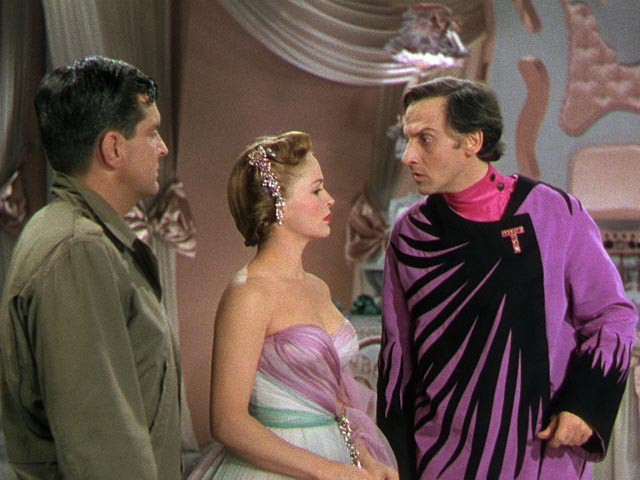 Mr. Zabladowski (Peter Lind Hayes) and Heloise Collins (Mary Healy) confront the musical despot Dr. Terwilliker (Hans Conried) in Dr. Seuss
Mr. Zabladowski (Peter Lind Hayes) and Heloise Collins (Mary Healy) confront the musical despot Dr. Terwilliker (Hans Conried) in Dr. Seuss
Bart takes it upon himself to thwart Dr. T’s dictatorial plans. He first appeals to Mr. Zabladowski’s practical side, then suggests a more personal incentive: marrying Heloise and becoming Bart’s stepfather. Ultimately, Bart and Mr. Zabladowski must join forces to escape the dungeons and devise a way to sabotage Dr. T’s scheme. They create a device that distorts music into chaotic noise, a contraption so volatile it threatens to destroy the entire institute.
The 5000 Fingers of Dr. T is rich with imaginative details and surreal sequences. Menacing twins joined by a long beard glide on roller skates, guards march in regimented lines, and sets utilize distorted perspectives and matte paintings to evoke Dr. Seuss’s iconic illustrations in live action. The film features a series of demented musical numbers, including a hypnotic tango duel between Dr. T and Mr. Zabladowski, a dungeon ballet with prisoners playing fantastical Seussian instruments, and a disturbing elevator descent overseen by a masked figure reminiscent of an executioner. The highlight is arguably the “Dress Me” number, a showcase of Dr. Seuss’s playful wordplay as Dr. T is adorned in his outlandish dictator’s uniform.
 The creative use of matte shots …
The creative use of matte shots …
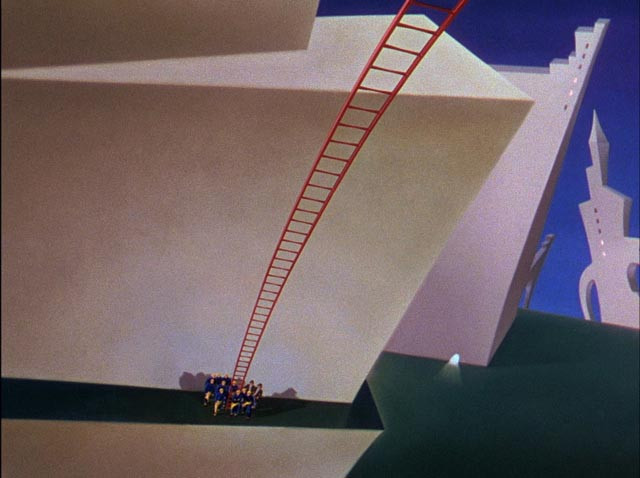 … and distorted perspectives to create Dr. Seuss
… and distorted perspectives to create Dr. Seuss
Beneath the surface of its fantastical plot, The 5000 Fingers of Dr. T explores deeper themes. Bart’s performance anxiety is amplified to absurd levels, reflecting a post-war unease with artists and intellectuals, possibly intertwined with a subtle nod to working-class values. While the political undertones are complex and perhaps contradictory, especially considering the film’s release during the Red Scare era, the film is unified by its dreamlike logic and Bart’s palpable fear of his mother falling under the sway of a sinister father figure. The portrayal of Dr. T as a conflation of fascism and the effete intellectual is a problematic aspect, reflecting mid-century American anti-intellectualism. However, the film’s focus on Bart’s resistance to authoritarian control offers a positive counterpoint to these regressive elements.
The cast delivers compelling performances, with Peter Lind Hayes and Mary Healy providing a relatable anchor to the film’s eccentricity as a sitcom-like couple. Tommy Rettig shines as Bart, the resourceful and determined child protagonist. However, Hans Conried’s portrayal of Dr. Terwilliker is undeniably the film’s centerpiece, a manic and unforgettable comedic performance. The dungeon ballet, featuring emaciated, green-tinged dancers, evokes a darkly comedic vision of Dante’s Inferno. The film’s ensemble of “minions,” a motley crew of working-class types, adds another layer of bizarre charm.
 Dr. T
Dr. T
Ultimately, The 5000 Fingers of Dr. T is a story about a child’s feelings of powerlessness and his journey to overcome adult oppression and reshape his world. Despite its imperfections and deviations from conventional filmmaking, it remains a captivating and unique piece of entertainment that demands to be experienced on its own terms. Its enduring appeal lies in its surreal visuals, memorable musical numbers, and exploration of childhood anxieties, making it a fascinating, if peculiar, entry in cinematic history and a testament to the boundless imagination of Dr. Seuss.
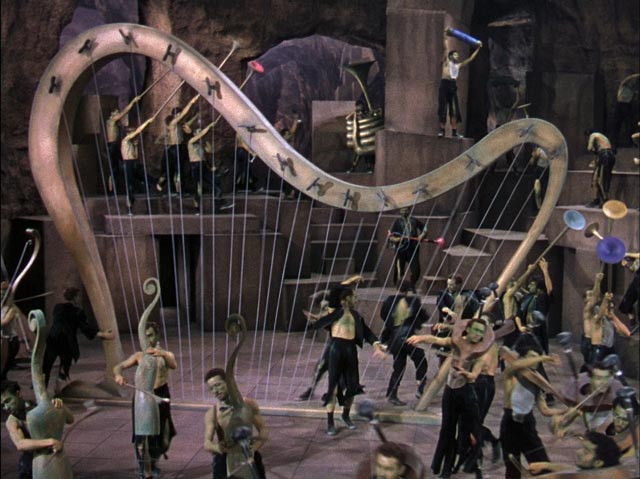 The dark and menacing dungeon ballet in Dr. Seuss
The dark and menacing dungeon ballet in Dr. Seuss
